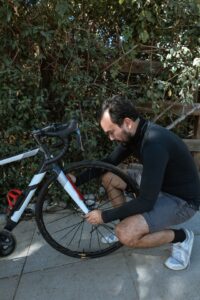Pedaling Safely Through the Urban Jungle
Cycling is a liberating and eco-friendly mode of transportation, but when it comes to sharing the road with cars, trucks, and buses, safety is paramount. As a cyclist, I’ve had my fair share of experiences navigating busy roads, and I’m here to share some valuable tips on how to cycle safely amidst traffic.
1. Be Visible
Being seen is the first step to staying safe on the road. Invest in bright and reflective clothing, especially when riding in low-light conditions. Equip your bike with front and rear lights and consider adding reflective tape to your helmet and frame. Make yourself as visible as possible to ensure that drivers can spot you from a distance.

2. Know the Rules of the Road
Understanding and obeying traffic rules is crucial. Just like cars, bicycles are subject to traffic laws. Familiarize yourself with hand signals, stop signs, and right-of-way rules. Ignorance of the law is not an excuse, and following these rules will help you predict and react to the behavior of other road users.
3. Choose Your Route Wisely
Planning your route can make a significant difference in your safety. Whenever possible, opt for bike lanes or dedicated cycling paths. Use cycling apps or maps to identify bike-friendly routes and avoid heavily congested roads. If you must ride on busy streets, plan your journey during less congested times, such as early mornings or late evenings.
4. Be Predictable
Erratic cycling behavior can confuse drivers and lead to accidents. Maintain a steady and straight line when riding, signal your turns and stops clearly, and avoid sudden swerves. Being predictable in your movements allows motorists to anticipate your actions.
5. Stay Alert and Focused
Distractions are a recipe for disaster on busy roads. Keep your full attention on the road ahead, and avoid distractions like headphones or texting while riding. Stay aware of your surroundings, including vehicles, pedestrians, and road conditions. Listening to traffic sounds can provide valuable information about approaching vehicles.
6. Use Mirrors
Handlebar or helmet-mounted mirrors can be incredibly helpful for monitoring traffic behind you. Mirrors give you a clear view of approaching vehicles, allowing you to react appropriately. Regularly checking your mirrors, especially before making turns or changing lanes, enhances your situational awareness.

7. Maintain Your Bike
A well-maintained bike is a safe bike. Regularly inspect and service your bicycle to ensure that it’s in good working condition. Pay special attention to brakes, tires, and lights. Adequate tire pressure and functional brakes are essential for quick stops and safe handling in traffic.
8. Ride Defensively
Assume that not all drivers see you, even if you’re visible. Defensive cycling means anticipating potential hazards and having an escape plan ready. Keep a safe distance from parked cars to avoid sudden door openings, and watch out for right-turning vehicles at intersections. Don’t assume that drivers will yield the right of way; make eye contact when possible to ensure they acknowledge your presence.
9. Respect Pedestrians
Sharing the road isn’t limited to cyclists and motorists; pedestrians play a crucial role too. Be courteous and yield to pedestrians at crosswalks and intersections. When cycling on shared paths, use your bell or call out a friendly warning to let pedestrians know you’re approaching.
10. Invest in Safety Gear
Safety gear can make a significant difference in your well-being on the road. Always wear a properly fitting helmet to protect your head in case of a fall. Consider additional protective gear like gloves, knee and elbow pads, especially if you’re cycling in high-traffic areas or at higher speeds.
In conclusion, cycling in traffic may seem daunting, but with the right knowledge and precautions, it can be a safe and enjoyable experience. Remember that your safety is in your hands. By being visible, following traffic rules, planning your routes carefully, and maintaining focus and alertness, you can confidently navigate even the busiest of roads. Cycling is not just a mode of transport; it’s a way to connect with the world around you, and by cycling safely, you ensure that your journeys are both enjoyable and secure.

